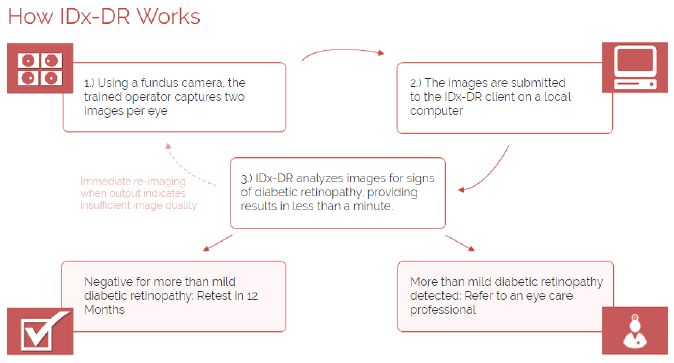On April 11, 2018, the United States Food and Drug Administration (USFDA) permitted marketing of the first medical device to use artificial intelligence to detect greater than a mild level of the eye disease - diabetic retinopathy in adults who have diabetes41.
The device - IDx-DR, is a software program that uses an artificial intelligence algorithm to analyze images of the eye taken with a retinal camera called the Topcon NW400. IDx-DR is intended for use by health care providers, to automatically detect more than mild diabetic retinopathy (mtmDR) in adults (22 years of age or older) diagnosed with diabetes who have not been previously diagnosed with diabetic retinopathy. IDx-DR is indicated for use with the Topcon NW400.
IDx-DR is the first device authorized for marketing which provides a screening decision without the need for a clinician to interpret the image or results, thereby, making it usable by health care providers who may not normally be involved in eye care. The FDA is permitting marketing of IDx-DR to IDx LLC.
Diabetic retinopathy occurs when high levels of blood sugar lead to damage in the blood vessels of the retina, the light-sensitive tissues at the back of the eye. Diabetic retinopathy is the most common cause of vision loss among the more than 30 million Americans living with diabetes and the leading cause of vision impairment and blindness among working-age adults. Early detection of retinopathy is an important part of managing care for the millions of people with diabetes, yet many patients are not adequately screened for diabetic retinopathy since about 50 percent of them do not see their eye doctor on a yearly basis. This decision permits the marketing of a novel artificial intelligence technology that can be used in a primary-care doctor's office.
The FDA evaluated data from a clinical study of retinal images obtained from 900 patients with diabetes at 10 primary care sites. The study was designed to evaluate how often IDx-DR could accurately detect patients with more than mild diabetic retinopathy. In the study, IDx-DR was able to correctly identify the presence of more than mild diabetic retinopathy 87.4 percent of the time and was able to correctly identify those patients who did not have more than mild diabetic retinopathy 89.5 percent of the time.
Patients who have a history of laser treatment, surgery or injections in the eye or who have any of the following conditions should not be screened for diabetic retinopathy with IDx-DR: persistent vision loss, blurred vision, floaters, previously diagnosed macular edema, severe non-proliferative retinopathy, proliferative retinopathy, radiation retinopathy or retinal vein occlusion. IDx-DR should not be used in patients with diabetes who are pregnant as diabetic retinopathy can progress very rapidly during pregnancy and the device is not intended to evaluate rapidly progressive diabetic retinopathy. IDx-DR is only designed to detect diabetic retinopathy, including macular edema; it should not be used to detect any other disease or condition. Patients will still need to get a complete eye examination at the age of 40 and at 60, and also if they have any vision related symptoms like persistent vision loss, blurred vision or floaters.
IDx-DR was reviewed under the FDA's De Novo premarket review pathway, a regulatory pathway for some low- to moderate-risk novel devices for which there is no prior legally marketed device. IDx-DR was granted Breakthrough Device designation - which means that the FDA provided intensive interaction and guidance to the company on efficient device development, to expedite evidence generation and the agency's review of the device. To qualify for such designation, a device must provide for more effective treatment or diagnosis of a life-threatening or irreversibly debilitating disease or condition and meet one of the following criteria - the device must represent a breakthrough technology; there must be no approved or cleared alternatives; the device must offer significant advantages over existing approved or cleared alternatives; the availability of the device is in the best interest of patients.
How IDx-DR works
A doctor uploads the digital images of the patient's retinas to a cloud server on which IDx-DR software is installed. If the images are of sufficient quality, the software provides the doctor with one of two results: (1)"more than mild diabetic retinopathy detected: refer to an eye care professional" or (2) "negative for more than mild diabetic retinopathy; rescreen in 12 months." If a positive result is detected, patients should see an eye care provider for further diagnostic evaluation and possible treatment as soon as possible.

Figure 1: Illustration on how IDx-DR works (Adapted from: Product Catalogue42)
Recent updates on Artificial Intelligence, Deep Learning & Technology companies
This approval from the US FDA is a welcome news for large technology companies like Google, Microsoft, and IBM, all of whom have made big investments in the medical AI space. Google had recently announced its AI breakthrough which can successfully predict cardiovascular problems such as heart attacks and strokes simply from images of the retina, with no blood draws or other tests necessary. The results of the Google AI research have been published in an article entitled "Prediction of Cardiovascular Risk Factors from Retinal Fundus Photographs via Deep Learning" in Nature Biomedical Engineering43. The study concluded that - the results have provided evidence that deep learning may uncover additional signals in retinal images that will allow for better cardiovascular risk stratification. In particular, they could enable cardiovascular assessment at the population level by leveraging the existing infrastructure used to screen for diabetic eye disease.
Footnotes
41 https://www.fda.gov/NewsEvents/Newsroom/PressAnnouncements/ucm604357.htm
42 https://www.eyediagnosis.net/idx-dr
43 http://www.nature.com/articles/s41551-018-0195-0
The content of this article is intended to provide a general guide to the subject matter. Specialist advice should be sought about your specific circumstances.

